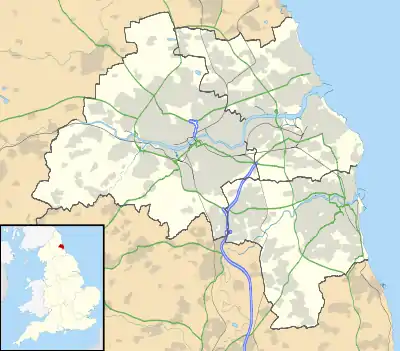Coxlodge
Coxlodge is an area situated between Fawdon, Gosforth and Kenton in Newcastle upon Tyne, England.
History
By order of the Local Government Board on 20 September 1872, the parishes of South Gosforth and Coxlodge were constituted into an urban district, the South Gosforth Local Board. After the 1894 Local Government Act, it became the South Gosforth Urban District Council. A year later, by a Northumberland County Council order dated 14 March 1895, the title was changed again to Gosforth Urban District Council. The parishes of Coxlodge and South Gosforth were amalgamated into the parish of Gosforth in 1908. The Gosforth Urban District Council was finally abolished on 1 April 1974 to become part of Newcastle Metropolitan Borough Council.[1]
The development of the colliery caused the population to expand from just 108 in 1801 to 965 in 1831.[2] The Coxlodge Hotel was built in 1868 and later became the Trap Public House.[3] By 1878 the population was 1538, and the creation of housing for miners continued into the 20th century.[2] Additional council housing was built in the aftermath of World War One and after World War Two many of the miners cottages were replaced with additional council housing.[2]
A school and Roman Catholic Church and School was built in 1861.[2] A Methodist Chapel was built in 1817, and then replaced in 1874.[2] In 1877 a Board School was built.[2]
Mining

Coal mining had been in the area as early as 1757, and Coxlodge Colliery was developed by Matthew Bell and Charles John Brandling in 1809/10.[2][4] There were two pits in the Coxlodge Colliery, the Jubilee Pit, which was on Jubilee Road opposite Jubilee Crescent, and the Regent Pit which is now the Regent Centre business park and St Charles R.C. School next to the current Metro line.
The colliery closed on 16 June 1894 with the miners being transferred to other local pits.[4] Some of the spoil was later used in the construction of the runway at Newcastle Airport.[2]
Notable residents
Notable people who were born in Coxlodge include Tommy Glidden, an English footballer.
- Coxlodge Hall
A number of wealthy people lived in a large residence called Coxlodge Hall, which was built in 1796 by Job Bulman, a medical man originally from Gateshead who had made his money in India. Bulman lived there until he died in 1818. The hall was sold a number of times and occupants included the soap manufacturer Thomas Hedley and shipbuilders Andrew Leslie and Sir Rowland Hodge. The Hall itself was destroyed by fire in 1877, but was rebuilt two years later. The building was eventually used as a private school until it was demolished in 1939.[5] A lodge on Gosforth High Street and the Coach House or Stables still survive.[6] In 1950 the coach house was eventually turned into offices. The previous owners were Summers-Inman Construction and Property Consultants, who bought the coach house of Coxlodge Hall in 1972 and had since renovated the location.[7]
In 2018 McDougall Dodds unveiled plans to turn the site into 8 residential properties, which then in-turn went on the market in 2020.[8]
Transport

The nearest Tyne & Wear Metro stations are Fawdon and Wansbeck Road.
There used to be a railway station called Coxlodge station, which was in use between 1905 and 1929, on the Ponteland and Darras Hall Branch of the North Eastern Railway.[9] The architect's plans of 1903 indicate that Coxlodge station was actually to be known as Fawdon, which became the Metro station name decades later. By 1973 the platform and buildings had gone, but the signal box remained until some time later; itself eventually being demolished. The site of this station is now occupied by Fawdon Metro station, which opened in 1981.[10]
St Nicholas Hospital
In the 1850s Newcastle upon Tyne's hospitals for mentally ill patients were overcrowding;[11] a new asylum was promised in Coxlodge, where a 50-acre (200,000 m2) farmstead had been purchased. It opened as Newcastle upon Tyne Borough Lunatic Asylum in July 1869. In 1882 it changed its name to Newcastle upon Tyne City Lunatic Asylum.[11] In 1948 the National Health Service took over the hospital and changed the name to St Nicholas Hospital.[11]
References
- "Reference number UD.GO". Tyne and Wear Archives Service. Cite journal requires
|journal=(help) - "Tyne and Wear HER(13783): Coxlodge colliery village - Details". TW Site lines. Retrieved 6 May 2017.
- "Tyne and Wear HER(9968): Coxlodge, Kenton Road, The Trap Public House (Coxlodge Hotel) - Details". TW Site lines. Retrieved 6 May 2017.
- "Coxlodge Colliery". The Durham Mining Museum. Retrieved 4 May 2008.
- Faulkner, Thomas; Lowery, Phoebe (1996). Lost Houses of Newcastle and Northumberland. Jill Raines. p. 16. ISBN 978-0951649428.
- "Newcastle upon Tyne". northumbrian-coast.co.uk. Archived from the original on 26 July 2008. Retrieved 4 May 2008.
- "Newcastle Office". Summers-Inman Construction and Property Consultants. Retrieved 29 September 2008.
- Ford, Coreena (9 May 2019). "Former Gosforth mansion to be transformed into luxury flats and houses". The Evening Chronicle. Retrieved 23 February 2020.
- "Ponteland Light Railway & Darras Hall Branch". Northumbrian Railways. Retrieved 26 April 2008.
- "Coxlodge Station". Disused Stations. Retrieved 6 January 2015.
- "St Nicholas Hospital, Gosforth - Reference number HO.SN". Tyne & Wear Archives Service. Retrieved 6 January 2015.
